
Back on Amtrak
The vibrating hum and
the xylophone ring of my iPhone woke me from my slumber at 3 a.m,
followed by the rude buzzing of the clock radio. I silenced them
both and stumbled into the kitchen.
I threw a cup of
rolled oats into a Pyrex bowl, poured in some water and stuck it
in the microwave for 10 minutes. Then I grated a knob of ginger
root, placed the shavings into a tea ball and tossed it into a
small pot of boiling water to simmer.
I chucked a handful
of frozen berries into the blistering hot oatmeal along with a cup
of almond milk and a blob of honey. The oatmeal cooled down
quickly and its texture became perfect.
I ate the
oatmeal and sipped on the ginger root tea while I watched my Baby
Ruh daintily separate her gourmet dog food from the dry kibbles, devour the former and reject the latter. I washed my dirty dishes and
took her for a walk around the block.
It was 6 o’clock when
we returned and I was down to the wire: I packed my meds into a
TSA-approved quart bag, gave my sleeping Jennifer Wren a kiss on
the forehead and hugged my Baby Ruh goodbye.
I left the house and wheeled
my carry-on to Central Avenue where I jumped on the 66 bus. Upon
reaching downtown I transferred to the #50 bus and arrived at the
Albuquerque Sunport by seven.
I walked to the
meditation room, closed my eyes and relaxed. After 10 minutes I
found an empty bathroom, locked myself in the handicap stall and
stripped down to my boxers.
I stuffed my pants and my
shirt into the carryon, along with my gadgets, wallet, watch and
anything else that would set off the full body scanner or get lost
on the conveyor belt. I pulled on my purple board shorts — the
ones with the lightning bolts — and slipped on my black
University of New Mexico tee shirt (go Lobos!).
Then I rolled my bag out of
the bathroom, into the great hall, up an escalator and into the
back of a long line of people eagerly waiting to pass through
security.
I showed my driver’s license
and boarding pass to an officer who studied me carefully, made
some small talk, checked my ticket and waved me to the back
of a line where I placed my shoes in a gray plastic basket and
hoisted my bag onto the conveyor.
I entered an acrylic full-body scanner, placed my stocking feet into position, raised my
hands above my head and was blasted with invisible electromagnetic
waves.
After 15 seconds I was deemed
harmless and exited the scanner. Meanwhile, my luggage and shoes
were being examined with a high resolution, full-color X-ray
machine. I retrieved them after they passed inspection and slipped
on my shoes. I walked to a bathroom, locked myself into a cubicle,
put on my traveling clothes, my wallet, my watch and all my other
little gadgets.
I was fit to fly
and, having successfully made my way through one of America’s most
high-tech airport security networks, felt safe as a child, relaxed
as a smile and cool as a cucumber even though I had chosen to
travel on September 11, 2013.
I also wasn’t hungry:
That quart of oatmeal hit the spot and I didn’t need to spend my
money at one of the Sunport’s overpriced restaurants. And even if
I did get hungry I could grab some Nature Valley Sweet and Salty
Peanut candy bars that I had stashed in my bag.
I walked to the
Southwest Airlines gate and boarded a near-empty redeye bound for
Phoenix where I claimed a whole row of seats to myself.
But this placid scene
changed after I transferred to my connecting flight. I got
squeezed into a tight seat on a packed airplane bound for
Milwaukee and the Greenbay Packers/Redskins game.
After touching down in “Brew
Town” — in a landing the flight attendant called “smooth as
freshly-churned butter” — I was met by Owen Goldin at Arrivals in his
Smart car. “It’s made by Mercedes-Benz,” he said proudly as I
marveled at its elfin proportions.
Owen and I first met
as freshman at St. John’s College in Annapolis, Md. He was a poet
and a brilliant scholar who helped me fake my way through junior
year genetics and senior year relativity. He is now a
distinguished professor in philosophy at Marquette University.
Owen drove to the
Milwaukee River where we walked along its banks and reminisced
about the good ol’ days. I complimented him on his rugged,
“weathered” looks (which he took in good humor) and I praised the
music videos that he had been posting on the World Wide Web.
Here’s one I particularly like:
After the hike we
drove to the Stonefly Brewing Company in the Riverwest
neighborhood where I drank a pint of the Star Destroyer Stout
(9.5%ABV!) and a pint of Four Wolves English Ale, each at $4 a
glass. I was glad to revisit this classic bar with its colossal
mouse trap hanging from the wall.
As the sun began to
set Owen whisked me to the modern Amtrak station where I caught
the last southbound train to Chicago.
Now I’m sitting in a
forward-facing seat of the Hiawatha on a one-way, 70-mile train
ride to Glenview, Illinois: its last stop before it arrives in The
Windy City.
The Hiawatha lacks
the frills one finds in most long-haul trains, like regularly
spaced air vents and swivel lighting. There are, however, plenty
of electrical outlets. The train runs smoothly on an endless
ribbon of hardened steel, as smoothly as freshly churned butter.
The conductor is polite and tells me I need to cross the tracks
when I arrive in Glenview so that I can connect with the local
train.
Glenview, Illinois. 9 p.m.
I sit beneath a fuzzy
half-moon. I have no idea which way is north or south and I don’t
care. I just don’t care.
It’s nice to sit
here, motionless, decompressing from a long day of travel on a
hot, humid late-summer evening.
I’m 20 miles from my
final destination and I’m supposed to jump on the Metra North
commuter train that will take me to Deerfield.
I see the lights of
the northbound Metra appear in the distance and when it arrives I
climb on board. The car is practically empty and split into two
levels. The seats on the ground floor can be flipped over so that
a party of four can sit facing each other.
My ticket costs only
$3 and is issued by a tall young man who cuts a handsome figure in
his crisp white shirt, conductor hat and tie, scanner, ticket
holder and puncher, as well as the time-honored shiny silver
change-maker.
Deven, Bonnie Belle’s
16-year-old son, is waiting for me at the Deerfield Metra Station.
I load my bags into the back of his SUV and we drive to Highland
Park and his mom’s apartment.
After we arrive I tell Bonnie
that she needs to keep my schedule wide open because I want to
meet up with Jim, whom I haven’t seen in over a year. It has been
difficult for us to coordinate our schedules lately because he’s
been spending a lot of time at his factory in China. Bonnie sets
me up in her daughter’s old bedroom and I get a good night’s
sleep.
Jim picked me up
early the next morning. We parked his Mercedes G-Wagon illegally
in a garage across from the Highland Park train station and jumped
on the Metra North, bound for Chicago. We arrived at the Ogelvie
Transportation Center within the hour where I bought a $10 CTA bus
pass. This would cover our bus fares for the day and I slipped it
into my shirt pocket, behind my iPhone.
We jumped on a bus
that took us to Randolph Street where we descended into an
underground Metra Station. From there we caught an electric train
that took us directly beneath the McCormick Place.
We climbed a flight
of stairs and found ourselves within the vast sun-splashed atrium
of the 2.6 million sq. ft. convention center. Jim, who usually
commutes to the city by car, marveled at the ease by which we were
able to make it from Highland Park to the heart of Chicago.
There were two trade
shows “co-located” at the McCormick that day. The first was “the
Midwest’s Leading Advanced Manufacturing Event for Technology,
Suppliers, Education & Networking” and the other was “Print 13.”
There was something for both of us to enjoy and we spent a few
hours chatting with the exhibitors and checking out the cool
machines.
On the way home I discovered
that I had lost the $10 CTA bus pass that I had bought earlier in
the day and I felt terrible because we had barely made a dent in
it. Our foray into public transportation had been going so well
and I was usually careful about keeping track of such things. The
pass must have slipped out of my shirt pocket when I was checking
my iPhone. I should have put it in my wallet.
Jim grilled me, “How
could you lose the ticket?”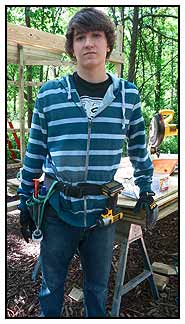 but then he backtracked and said
consolingly, “these things happen.” He flagged down a cab that got
us back to the transit center and the northbound Metra train which
got us back to Highland Park in record time. Thankfully the “G-
Wagen” had not been towed or ticketed while we were gone.
but then he backtracked and said
consolingly, “these things happen.” He flagged down a cab that got
us back to the transit center and the northbound Metra train which
got us back to Highland Park in record time. Thankfully the “G-
Wagen” had not been towed or ticketed while we were gone.
That night we drove
Jim’s son, Brian, to his Boy Scout meeting in the neighboring town
of Deerfield. Brian had sprouted like a weed since I last saw him.
He was bigger than me now and also very close to earning his Eagle
Scout award: He just needed to submit his final project and pass
the board of review.
Brian had built a
sturdy shelter in the Heller Nature Center in Highland Park for
his Eagle Scout project where people can rest and observe
wildlife. It is an elegant, rustic structure that rose from
original plans and 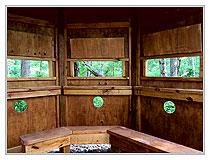 architectural models. Brian had an enthusiastic
and energetic workforce of friends and family at his disposal to
see the project to completion, including his dad who is an
accomplished woodworker. Jim, whose motto is “measure twice and
cut once,” had built many fine pieces of furniture for his house
including the building blocks Brian had played with when he was a
boy.
architectural models. Brian had an enthusiastic
and energetic workforce of friends and family at his disposal to
see the project to completion, including his dad who is an
accomplished woodworker. Jim, whose motto is “measure twice and
cut once,” had built many fine pieces of furniture for his house
including the building blocks Brian had played with when he was a
boy.
At the Boy Scout
meeting I asked Brian’s scoutmaster if he thought that combining
girls and boys into the scouting movement was sacrilege. This
question had been weighing on my mind ever since the Scouts had
decided to allow gay boys into their organization and I wanted a
professional opinion.
“Only in the United
States and certain Moslem countries are boys and girls
segregated,” the rotund, jolly Scoutmaster told me. “In the rest
of the world girls and boys are combined together in an
organization called The Scouts.”
I mentioned to him,
in an offhand way, that I had been an Eagle Scout during my youth.
“You still are an Eagle Scout,” he said. “Once an Eagle Scout,
always an Eagle Scout!”
After we settled
Brian in at the scout meeting, Jim drove me to a nearby sushi bar
where he ordered up a storm of exotic favorites for the two of us,
as well as a smooth bottle of Saki. Jim is a great person to eat
Sushi with because nobody knows Sushi like he does. Nobody.
At the end of dinner
I grabbed the extortionate check from the waitress ($180 including
tip) and said, “I’ve got it!” I whipped out my Amtrak Guest
Rewards credit card and saw Jim’s jaw practically dropped to the
floor in astonishment at this unexpected and unprecedented
gesture.
The next few days
were spent in long hikes alongside the windy shores of Lake
Michigan and the Greenbay Trail. As Jim and I walked merrily along
these footpaths we clutched six pound barbells in our hands. Jim
said they would help strengthen our core muscles, biceps and
triceps, but I just stayed focused 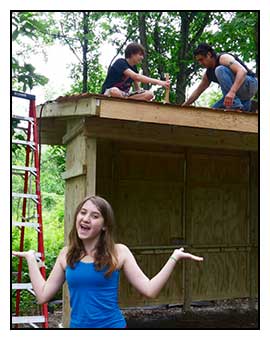 on not injuring myself with
those goddamn weights. The leaves were starting to turn and the
air was cool as the sun bathed us with her golden rays beneath a
perfectly cloudless, blue Chicago sky.
on not injuring myself with
those goddamn weights. The leaves were starting to turn and the
air was cool as the sun bathed us with her golden rays beneath a
perfectly cloudless, blue Chicago sky.
I’d like to say a few
words about Ashley, Jim’s daughter: In addition to all her other
skills (she is an excellent writer and a budding young actress)
she is also an accomplished marksman. So, at Jim’s request, I
would like to share with you a short film that displays her
precision shooting.
On my last full day
in Chicago Jim and I went bar hopping met up with Stephanie, Jim’s
Belizean friend and her cousin, Victoria. We ended up at the
Miramar Bistro, a fancy Cuban restaurant in the neighboring town
of Highwood, where we downed three dozen 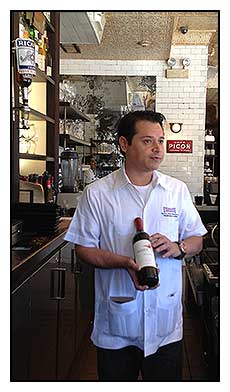 oysters and three very
expensive bottles of champagne: Jim’s treat.
oysters and three very
expensive bottles of champagne: Jim’s treat.
I got so drunk I can’t
remember how I made it home and but I do recall that I had an
unfortunate encounter with one of Ashley’s rose bushes in the
front lawn of Jim’s house. It tore my brand new shirt with a
vengeance and embedded me with some wicked thorns. Brian and
Ashley raced to my aid, applied first aid, cleaned and disinfected
my wounds and got me into bed.
Another casualty of that
night of Bacchic revelry was the mysterious loss of my iPhone
which I always kept securely attached to me with a lanyard that I
wear around my neck. When I woke up the next morning I noticed it
was gone and figured I had lost it.
The unit was password-protected so I was not particularly concerned about a security
breach; plus, I could call Apple and have all the information in
the phone erased, should it come to that.
“Easy come, easy go,”
I said philosophically, cursing my bad luck for having lost my
precious iPhone.
Jim had given me that
iPhone4S year ago in an attempt to bring me “to the next
level,” as he once put it. He was a patient teacher and taught me
how to text, synchronize my e-mails and surf the web.
The phone and I had
become inseparable since then, even though I was not much of a
conversationalist. I loved to listen to Charlie Parker and Miles
Davis on Pandora, as well as “Click and Clack, the Tappit
Brothers” and “Morning Edition” on NPR.
But of all the things
the iPhone could do, the thing I liked most was the “app” that
helped me catch city buses. Thanks to that “app” I know exactly
where the city buses are at all times and I never have to
frantically rush to catch one. This nervous tendency to “rush” is
what caused me to break my jaw in June of 2012: While running to a
bus stop, I tripped on my sandal and landed chin-first on the
sidewalk.
Oh well, my iPhone was now
gone forever and freaking out would not bring it back. I was
entirely to blame and was resigned to return to my stupid and
unreliable Virgin Mobile phone. Nevertheless, I found reassurance
in the wise words of Horatio Alger whom I had been reading earlier
that day: “Don’t think too much of the past which cannot be
recalled: Resolve not to repeat your folly and all may yet be
well.”
As it turns out, Jim found my
phone in his house later that day. I was thrilled and resolved to
take much better care of it in the future.
Jim was the landlord
of a successful barber shop in Gurnee, Illinois. We visited the
shop and he offered to buy me a haircut. Jim instructed the
barber, Melinda, on how to cut my hair. “Let him have his fun,” I
thought. “It will all grow back. What harm can it do?”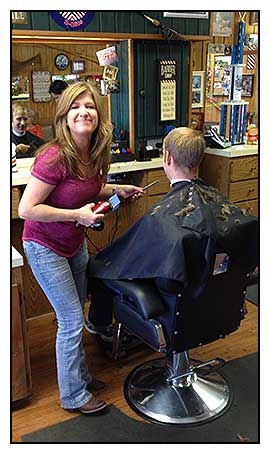
Jim told Mel to cut
my hair short-short, almost to the length it had been when I was a
little boy. She essentially gave me a crew cut and it felt great
but I barely recognized myself. Everybody who saw me from that
moment on liked the way I looked and paid me compliments. I was
shocked to see how a simple thing like a haircut could change the
way people perceived me.
Later that evening, four of
us — Melinda, her son, Jim and I — went out to dinner at the
Reflections Restaurant and Lounge on the east shore of Deep Lake
in Lake Villa, Illinois). It was there that I ate the best roast
duck I had ever eaten!
I have eaten duck a
few times in my life, mostly 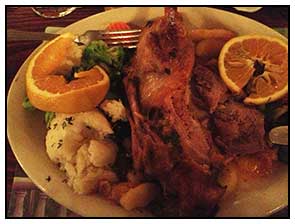 at Chinese restaurants, and each time
they were presented to me as flattened, segmented slabs of greasy,
artificially-colored red meat. This amazing bird, however, was
everything I had ever hoped a roast duck to be: juicy, flavorful
and lean. And at $15 (Jim’s treat), it was one of the more
reasonably priced items on the menu. In fact, it was featured as
the house special. Clearly, this restaurant had the preparation of
roast duck down to a fine science. If you are ever in Deep Lake,
do check out this place and order the duck.
at Chinese restaurants, and each time
they were presented to me as flattened, segmented slabs of greasy,
artificially-colored red meat. This amazing bird, however, was
everything I had ever hoped a roast duck to be: juicy, flavorful
and lean. And at $15 (Jim’s treat), it was one of the more
reasonably priced items on the menu. In fact, it was featured as
the house special. Clearly, this restaurant had the preparation of
roast duck down to a fine science. If you are ever in Deep Lake,
do check out this place and order the duck.
Jim’s birthday was coming up
so I gave him an 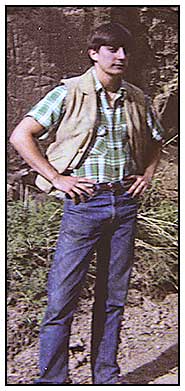 aluminized case for his iPhone that had his
picture printed on its front cover. I took that picture of him in
the late 70s with a cheap Instamatic. He was 17 and had come to
visit me while I was a student at St. John’s College in Santa
Fe.
aluminized case for his iPhone that had his
picture printed on its front cover. I took that picture of him in
the late 70s with a cheap Instamatic. He was 17 and had come to
visit me while I was a student at St. John’s College in Santa
Fe.
Jim liked my gift and
immediately replaced his protective case with the one I had given
him. He proudly showed it off to his family and friends and they
ooed and aahed. His children marveled at the sight of this dashing
young man who wasn’t much older than they were now.
After dinner Jim and
I drove back to Bonnie’s place but we hardly spoke. Instead, we
spent our time listening to National Public Radio and a dark
production of Arthur Miller’s “Death of a Salesman.” Jim (the
consummate salesman) turned up the sound and we both got lost in
the dialogue:
“ . . . I’ll
show you all the towns. America is full of beautiful towns and
fine, upstanding people. And they know me, boys, they know me up
and down New England. The finest people. And when I bring you
fellas up, there’ll be open sesame for all of us, ‘cause one
thing, boys: I have friends. I can park my car in any street in
New England, and the cops protect it like their own. This summer,
heh?”
(spoken byWilly Loman) Death of a Salesman by Arthur Miller
When we reached the
apartment Jim and I parted with a simple handshake. The next day I
would begin my epic train trip on Amtrak with Bonnie: my good
friend, traveling companion and the only person I know who is
crazy enough to undertake such a journey.
 |
Bonnie and I could
have taken Amtrak’s Southwest Chief from Chicago to LA. That would
have been the reasonable thing to do, with a distance of 2,256
miles and a traveling time of 43 hours.
Instead we climbed aboard
the Empire Builder, a train that took us to the northern US
border, skirted Montana and dropped us off in Portland, Oregon.
From there we jumped on board the Coast Starlight which took us to
LA. This trip would cover a distance of 3,457 miles and a
traveling time of 82 hours.
So, the distance that
Bonnie and I eventually covered on our train trip was 1,200 miles
and two days longer than if we had taken the Southwest Chief.
Most of the scenery
on the Empire Builder was flat farmland. The most spectacular
sight must have been the giant malted barley silos we saw before
we entered Glacier National Park, just when the sun was beginning
to set. So we never saw the Rocky Mountains — a big
disappointment.
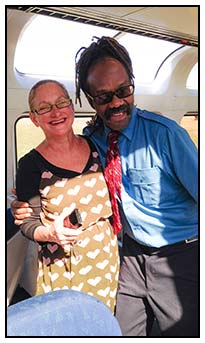 We did, however, get
a nice introduction into roomette train travel and Bonnie took to
it like a pro. Our attendant was Charles Pinner, a black man with
dreadlocks who has worked at Amtrak for 24 years. Charles had a
severe limp and yet he performed his job better than any train
attendant I have ever known. He was able to get an entire sleeper
car (upper and lower) ready for the bed at night and somehow got
us all awake and ready for action the next morning without missing
a beat.
We did, however, get
a nice introduction into roomette train travel and Bonnie took to
it like a pro. Our attendant was Charles Pinner, a black man with
dreadlocks who has worked at Amtrak for 24 years. Charles had a
severe limp and yet he performed his job better than any train
attendant I have ever known. He was able to get an entire sleeper
car (upper and lower) ready for the bed at night and somehow got
us all awake and ready for action the next morning without missing
a beat.
Charles had a lovely sense of
humor that charmed the ladies and he understood the intricate
mechanics and electronics of the sleeper car, as well.
At the beginning of
the trip I asked Charles if he could repair the dead electrical
outlet in our roomette. He managed to find the archaic breaker to
our room, buried in a mess of antiquated circuitry located at the
end of the car, and he reset it without breaking a sweat.
When Bonnie mentioned to
Charles that she was resigned to take a cold shower because the
water in the car was not heating up he said, “Oh no you don’t!”
and proceeded to “bleed” the system. Within minutes, she was able
to luxuriate under a stream of endless hot water.
Charles had nicknames
for the women of our sleeper car: “Blondie” was the name of our
neighbor with straw-colored hair and Bonnie became known as “Heavy
Bonnie” because her luggage weighed a ton.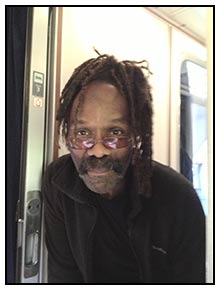
“Ladies and
gentlemen,” Charles announced to the car as we were settling in,
“we have a celebrity in our midst! We are graced with a world-
renowned movie star who has broken the hearts of millions. Let’s
have a big round of applause for Miss Bonnie Belle. Give it up for
Miss Belle!” and the whole sleeper car erupted in cheers for my traveling companion.
Bonnie, with her
gracious mannerisms and 16 different outfits, carried herself well
and looked like a petite supermodel straight out of the pages of
Vanity Fair. More than one passenger asked her if she was truly a
movie star to which she replied, “No, sadly, I am not.”
In addition to his
duties as sleeper attendant, Charles assisted in the dining car
during the rush hour. He told me that at some point in his Amtrak
career, when he was working as a cook in the kitchen of the dining
room car, he had arrived at “a moment of clarity” when he could no
longer eat animals. “I looked around me and I was surrounded by
dead animals and I realized that I had to become a vegetarian.”
Charles also served
as the sommelier of the wine tasting event held in the dining car,
an occasion only open to us first class passengers.
We sampled many
varieties of cheese and sipped four different kinds of wine. When
Charles found that he had a half bottle of wine left over, he said
that he would give it to anybody who could solve a riddle.
“How many seconds are
there in a year?”
“There are only 12,”
I shouted out: “January 2nd, February 2nd, March 2nd and so
on.”
Fortunately, earlier
in the train trip, Charles posed that very same riddle to Bonnie
and me while he was making up our roomette. I had no idea that the
solution to that riddle would later come in handy and so I won an
expensive half bottle of red wine even though I had an unfair
advantage over everybody else.
Charles posed another
riddle to us later, “Who was the president in 1975?” he asked.
“Richard Nixon?” I
replied, a little uncertain.
“No, it was Barack
Obama.”
“How do you
figure?”
“Because our current
President still had the name Barack Obama in 1975.”
We laughed once we
wrapped our minds around that joke, though it took me a while to
figure it out.
The food onboard
Amtrak has greatly improved since the last time I rode the rails,
and Bonnie and I made a point of never missing a meal. All our
meals came free with our ticket and all we had to do was lay down
a tip and pay for alcohol. But we hardly ever bought booze because
Bonnie had her bag stuffed with 12 oz. cans of Coors Light and I
had a dozen little 6.3 ounce bottles of Cabernet Sauvignon in my
carry-on.
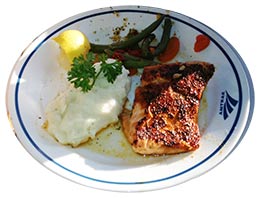 Our first dinner featured a
spice-rubbed Atlantic salmon fillet (normally $23.25). “Garnished
with a lemon widge and parsley, served with three grain rice pilaf
and vegetable medley (652 cal.),” read the lavish, slick menu. The
food was elegantly served on china plates with silverware. Those
nasty disposable plates of the Bush era were a thing of the past:
We were now being treated like royalty.
Our first dinner featured a
spice-rubbed Atlantic salmon fillet (normally $23.25). “Garnished
with a lemon widge and parsley, served with three grain rice pilaf
and vegetable medley (652 cal.),” read the lavish, slick menu. The
food was elegantly served on china plates with silverware. Those
nasty disposable plates of the Bush era were a thing of the past:
We were now being treated like royalty.
On the second evening
we ordered the Amtrak Signature Steak ($25.75): “A well-marbled
Black Angus USDA Choice flat iron steak, grilled to perfection and
cooked to order. Served with our signature Morel Wild Forest
Mushroom Sauce, accompanied by a baked potato with sour cream and
vegetable medley (589 cal.)”
The Chef’s Good
Morning Special ($10.75) greeted us for breakfast: “Southwest
quiche with a savory egg custard, roasted green chiles, garlic,
sautéed onions, corn and three cheeses wrapped in a pastry crust.
Served with roasted potatoes or grits and breakfast bread
selection (925 cal.).”
And for lunch we
tried the veggie and Angus steak burgers, specialty sandwiches,
and soup and salad combos.
The food was
plentiful, well-cooked, the service was outstanding and the view
from our seats was tip-top. I was glad to be riding first class.
Everybody else has to pay dearly for all their amenities; they
have no privacy or showers, and they sit on worn-out seats that do
not lay flat. It’s rough.
At the end of the
trip we gave Charles a $40 tip which he graciously accepted. He
probably deserved more but that was all we could afford.
The Empire Builder
arrived at Portland, Oregon 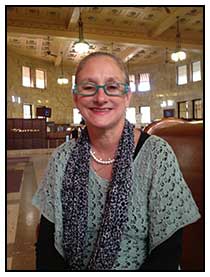 exactly on time and that marked the
end of the first leg of our journey. We had four hours to kill
before getting on our next train, the Coast Starlight. The station
was beautiful and we were allowed to store our luggage in a secure
room reserved for first class passengers. Unencumbered by luggage
and free of the train, we are ready to get some serious
exercise.
exactly on time and that marked the
end of the first leg of our journey. We had four hours to kill
before getting on our next train, the Coast Starlight. The station
was beautiful and we were allowed to store our luggage in a secure
room reserved for first class passengers. Unencumbered by luggage
and free of the train, we are ready to get some serious
exercise.
We spent four hours
walking through Portland, marveling at the majestic restored
Victorian homes, a mammoth synagogue and a vibrant downtown that
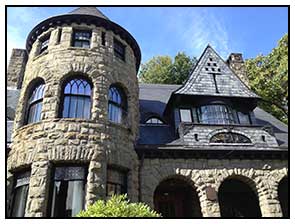 wound its way through hilly, tree-covered streets. I was
fascinated by a sign hanging in the window of a dry cleaner that
read “IF YOU ARE UNEMPLOYED AND NEED AN OUTFIT CLEAN FOR AN
INTERVIEW, WE WILL CLEAN IT FOR FREE.”
wound its way through hilly, tree-covered streets. I was
fascinated by a sign hanging in the window of a dry cleaner that
read “IF YOU ARE UNEMPLOYED AND NEED AN OUTFIT CLEAN FOR AN
INTERVIEW, WE WILL CLEAN IT FOR FREE.”
Soon Bonnie and I were seated
in the Parlor Car of the Coast Starlight, train #11, bound for Los
Angeles. Bonnie was seated opposite me and we were relaxing in
purple easy chairs, like the kind you would see in a family living
room, certainly not on a train.
Only first class passengers
were allowed to enter the Parlor Car; and to have the run of the
place for 30 hours was a dream come true, because I had heard so
much about it in the writings of other rail fans. I had also, long
ago, grown weary of riding in coach seats, restricted in my every
movement, having to pay for every little thing that came my way.
Trust me, I had paid my dues to coach.
The roomette that
Bonnie and I occupied on both 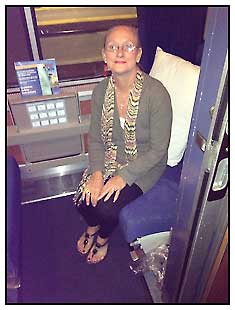 the Empire Builder (car #2730) and
the Coast Starlight (car #1130) were small, no more than seven
feet long, eight feet high and four feet wide. We occupied room 4
on the second level, located smack in the middle of the
aforementioned cars. I was told by my friends in the Amtrak
Forum that room 4 is one of the
quietest rooms in the sleeper car because it was furthest from the
stairway and the bathrooms. The position of the room also made it
least impacted by variations of the roadbed and the rails far
below us.
the Empire Builder (car #2730) and
the Coast Starlight (car #1130) were small, no more than seven
feet long, eight feet high and four feet wide. We occupied room 4
on the second level, located smack in the middle of the
aforementioned cars. I was told by my friends in the Amtrak
Forum that room 4 is one of the
quietest rooms in the sleeper car because it was furthest from the
stairway and the bathrooms. The position of the room also made it
least impacted by variations of the roadbed and the rails far
below us.
There was one bathroom on the
second level of the sleeper and a few on the bottom, including a
generous shower filled with plenty of towels, soaps and shampoos.
There were no restrictions on water use and one could stay in
there as long as one pleased.
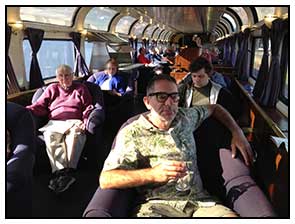 The two opposing
seats of our roomette folded out into a lower bed at night.
Another bed cleverly pivoted down from its resting place near the
ceiling to accommodate a second passenger.
The two opposing
seats of our roomette folded out into a lower bed at night.
Another bed cleverly pivoted down from its resting place near the
ceiling to accommodate a second passenger.
There were subtle
differences between the roomettes of the Empire Builder and the
Coast Starlight. One had a tiny, narrow closet while the other had
only a bar on the wall to hang clothes. One had LEDs to illuminate
the room, the other had light bulbs. The shower in one sleeper car
was much more spacious than the other and its water was activated
by pushing a button, while in the other the water simply came on
by turning a knob.
I preferred the older sleeper
car accommodations to that of the newer one because everything in
the older car seemed to work much better. Most of these cars are
old on the outside and refurbished on the inside, but the
electronics on board both look ancient.
The word on the street is
that brand new railroad cars are about to be released into the
system and, with Amtrak being more successful than ever before,
its future (at least for long-haul travel) may finally be
secure.
The winding train tracks
that lead to Santa Barbara traverse some of the most beautiful,
and rugged landscapes in America. It amazes me how our train can
climb up and down these steep mountain grades without tumbling
down the side. Some of the tunnels that we pass through seem to
go on forever.
Bonnie and I stake
out two of the purple easy chairs in the Parlor Car, in the
company of five hardcore rail fans, when our train suddenly stops
on a sidetrack and doesn’t budge.
One of these guys
stares intently at a scanner while holding a dog-eared copy of the
California regional timetable. Another fellow wears an Amtrak cap
and says, “We have to wait for the Northbound 14 train before we
can start moving again. We’re not going anywhere until we get the
highball signal.”
Bonnie and I are occupying
the best real estate on the Coast Starlight for some of the most
scenic landscape to be found anywhere and we’re not about to give
it up, even for a wine tasting. Bonnie’s got her Coors Light
(which she replenished in Portland) and I’ve got my little bottles
of cabernet, so we’re set.
The Coast Starlight
arrives at Los Angeles Union Station at 9 p.m., a half hour early,
and this gives us a chance to take our time in detraining,
collecting our wits, and touring the beautifully restored station
with its exquisite combination of Dutch Colonial Revival, Mission
Revival and Streamline Moderne architectural styles.
The last train to San Juan
Capistrano, the Surfliner, leaves at 10:30 pm and that gives us
plenty of time to admire the travertine marble floors, comfy
leather seats and garden patios. Our business class ticket for the
final, short leg of this journey was included in the 20,000 Amtrak
Guest Reward Points I spent for our ticket.
The difference
between coach and business class on the Surfliner is minimal: I am
given a choice between a small bottle of red or white wine
(Bonnie’s got her Coors Light, of course), and we are handed a
package of snacks. This hardly justified the extra cost of the
tickets (had we actually paid for a ticket), which was
significant. But one nice thing about traveling business class was
that I was able to tell my host, Joe, exactly what car I would be
in, because it was located directly behind the locomotive.
Joe was waiting to
greet us at the station, having walked there from his house. We
had not seen each other for five long years. I had been going
through some hard times the last few years with my mom’s 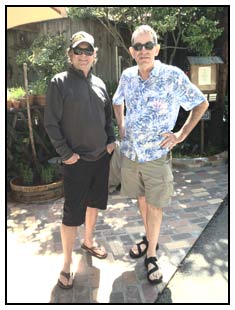 slow
decline and eventual death, but Joe’s Christmas cards always
arrived like clockwork, and when he learned we were coming through
he invited Bonnie and me to visit.
slow
decline and eventual death, but Joe’s Christmas cards always
arrived like clockwork, and when he learned we were coming through
he invited Bonnie and me to visit.
I suppose I should
have told Joe to bring his large SUV to pick us up but I didn’t
and so we had to schlep all our bags back to his house. “What do
you have in here? Bricks?” Joe asked Bonnie as he helped roll our
bags up the hill, past the old Mission Church.
It was past 11 p.m.
when we arrived at his house. “We don’t sleep together,” I told
Joe as the bedtime arrangements were being sorted out.
Bonnie said that she
was about to pass out so Joe got her quickly squared away in the
guestroom. Joe found me a pillow, sheets and a blanket and helped
me turn the living room sofa into a bed.
Afterwards we walked
into his backyard and beneath the bright glow of an enormous full
moon. “You almost need sunglasses to look at it,” Joe said.
Joe and I are the same age
and we have known each other since we shared the same 6th grade
class at Edgewood Junior High School. We were Boy Scouts in the
same troop, back in Highland Park, and tent mates at Camp Ma-Ka-Ja-Wan.
Joe helped me come to
terms with Los Angeles after my family moved to Woodland Hills
(just a few years after his family packed up and moved to Malibu)
and he was a reassuring voice on the telephone after I became a
freshman at St. John’s. I tried to teach him how to waltz and how
to dance free-form to his beloved Grateful Dead music. I fondly
remember how we used to cruise the streets of LA in his old
Porsche and the streets of Tijuana in my ’65 Ford Falcon.
As we got older Joe
tried his best to teach me how to sail, windsurf and ski while
introducing me to classic music like Pink Floyd and the Grateful
Dead. We skied Taos, Santa Fe and Big Bear together and he once
invited me to a Lakers’ Playoff game at the Staples Center where I
saw, with my own eyes, Shaq and Kobe dominate the court.
In many ways our lives ran
parallel to each other: Neither of us ever got married, had kids
or rose above the middle class. Yet both of us managed to find
good jobs and buy a house. Neither of us were geniuses or Don
Juans but we could hold our own in the romance department and we
always managed to stay gainfully employed, even during the worst
of times.
I always found it reassuring
to know that ol’ Joe was out there, somewhere, making ends meet.
And I figured if he could survive and thrive in this dog-eat-dog,
backstabbing world, then I could, too.
Laughter still
flickered in his eyes like the old days but when I inevitably
brought up the subject of my broken jaw (a bad habit of mine) he
said, in that off-hand, tough-love way of his, “Well, don’t expect
me to feel sorry for you.”
Whereupon I replied,
“You never have,” and gave him a significant look.
Joe always had a way of
telling me the things I really didn’t want to hear about myself
and I generally replied by saying something that was not
altogether true.
At 2 a.m. I suggested
that we assemble a Keurig fancy coffee maker that he had bought
online and had been delivered that very same day. It was the sort
of device that brews single servings of coffee, tea and hot
chocolate within a minute. The brewing takes place within little
disposable “K-Cups” and requires no cleanup.
After we unboxed the
device, deciphered the “chinglish” instructions and set it up, we
finally got the thing to work (although we did forget to install
the water filter). The device turned out to work as well as
advertised and Joe was pleased with his purchase. Now he could
quickly serve the most delicious gourmet hot drinks to his guests
without all the muss and fuss.
The next day I
treated Joe and Bonnie to breakfast at the Ramos House Café, which
prides 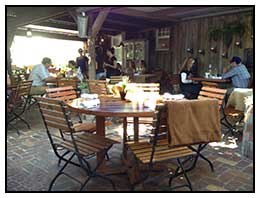 itself upon the age of its digs (1881). The owner lives and
works within the house; the wines are kept in the cellar; the
herbs are grown in the garden; the ice cream is turned out back,
and everything is made from scratch.
itself upon the age of its digs (1881). The owner lives and
works within the house; the wines are kept in the cellar; the
herbs are grown in the garden; the ice cream is turned out back,
and everything is made from scratch.
We sat out in a
rustic, enclosed courtyard in the open air. We were handed an
elegant tri-folded 3x3” menu with colonial type. We split our
orders between the organic heirloom summer squash hash & fried
poached eggs ($16) and the crab hash with bacon scrambled eggs &
citrus cream ($17). Delicious!
Afterwards we visited
a nearby curio shop called Cottage Home and Garden where I bought
a dozen little hand-crafted butterflies made from bird feathers.
The owner was amazed when I specifically asked for them because
she had just made a “flight” of them the previous day and put them
out for display that very morning. It was quite a happy
coincidence for both of us.
Then Joe drove us to
San Clemente beach where we walked six miles by the water’s edge.
Unlike the beaches that he could have taken us to (like Malibu or
Santa Monica), these pristine beaches, fronting expensive homes on
the cliffs, were virtually empty. As we looked out to sea, Joe
pointed to a group of young surfers clad in their black wet suits,
battling the waves.
“Grommets,” he
said.
“What’s a grommet?” I
asked.
“It’s a surfer
boy.”
Intrigued by a new slang word
to add to my vocabulary, I later googled it and this is what I
found.
In addition to our
rambling conversation, we played Frisbee and sunned ourselves on
the sand. It was so good to be back by the ocean. She was like an
old friend.
On the way home we
all pitched in and bought a bunch of mahi-mahi steaks and tiger
shrimp, and Joe barbequed a delicious meal in his backyard.
Joe left for work
early the next morning, and Bonnie and I gave him a hug and
thanked him for his hospitality. We left the house at about 9:30
and dragged our luggage downhill to the depot, much easier now
that we had gravity on our side. We each bought our $21 one-way
ticket at the station and were soon on our way back to Los Angeles
on the Surfliner.
My brother-in-law met
us at Los Angeles Union 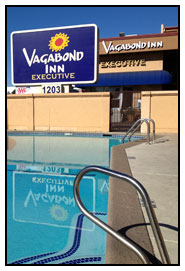 Station and drove us back to my sister’s
bungalow in Pasadena where we socialized and Bonnie got the royal
tour. Then we were driven to the Vagabond Inn on Colorado Blvd.
where we set up our base camp, showered and prepared for the
evening’s activities consisting of a lovely Friday night Sabbath
dinner in my sister’s backyard.
Station and drove us back to my sister’s
bungalow in Pasadena where we socialized and Bonnie got the royal
tour. Then we were driven to the Vagabond Inn on Colorado Blvd.
where we set up our base camp, showered and prepared for the
evening’s activities consisting of a lovely Friday night Sabbath
dinner in my sister’s backyard.
The next few days
found us caught up in a whirlwind of activity as Bonnie and I
became part of my grandnephew Nelson’s Bar Mitzvah
celebrations.
Just about everybody
in the family already knew and loved Bonnie so she fit right in.
Nelson delivered his Bar Mitzvah reading of the Torah on Saturday
morning surrounded by friends and family. He put on an excellent
performance and his delivery was uncharacteristically loud and
coherent, thanks to some theatrical training that he had received
in a school play that year.
Candy was handed out
to everybody early in the service and later, at a secretly
agreed-upon moment, 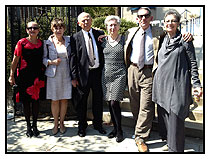 the children began throwing them back at the
Bar Mitzvah boy. This playful mayhem did wonders to lighten up the
solemnity of the occasion. I had never seen this ritual take place
during a Bar Mitzvah ceremony before and found it charming.
the children began throwing them back at the
Bar Mitzvah boy. This playful mayhem did wonders to lighten up the
solemnity of the occasion. I had never seen this ritual take place
during a Bar Mitzvah ceremony before and found it charming.
Bonnie and I enjoyed
the parties that followed the Bar Mitvah and it was a pleasure to
introduce her to family members that she had not already met.
Every event gave her an opportunity to dig deep into her luggage
and don a new outfit. She never looked the same way twice and
every outfit was prettier than the last.
Sunday arrived and it
was time for Bonnie to return to Chicago. Selma and I dropped her
off at the airport the next morning and my sister Linda moved into
my motel room at the Vagabond Inn to keep me company.
That night Selma took us to a
concert at the open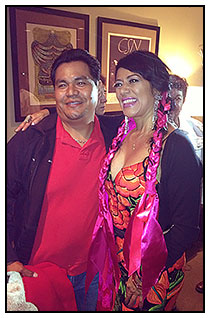 air Greek Theater where we saw Lila Downs, the
great Mexican singer, perform in a wild, multimedia extravaganza.
Intricately crafted videos of revolutionaries, skeletons and women
kneading corn dough formed a backdrop to this energetic lady’s
Spanish songs that made the packed house go crazy.
air Greek Theater where we saw Lila Downs, the
great Mexican singer, perform in a wild, multimedia extravaganza.
Intricately crafted videos of revolutionaries, skeletons and women
kneading corn dough formed a backdrop to this energetic lady’s
Spanish songs that made the packed house go crazy.
Later, a mariachi band took
the stage and gave Ms. Downs a breather. When she returned she
brought the audience to its feet with a song called “Mole!” Selma
had backstage passes for all of us and we got to meet Ms. Downs in
person.
Linda
and I were invited to stay the following night in the elegant suite at the Langham Hotel that was being occupied by my nephew’s wife, Chris.
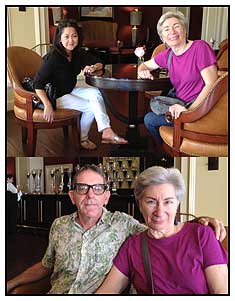 There I saw luxury
like I had never seen in my life. From its crystal chandeliers to
its plush carpeting, tea rooms and endless acres of perfect lawn,
this place exemplified the epitome of extravagance. But best of
all was its swimming pool and hot tub which provided me with some
welcome relaxation and tranquility.
There I saw luxury
like I had never seen in my life. From its crystal chandeliers to
its plush carpeting, tea rooms and endless acres of perfect lawn,
this place exemplified the epitome of extravagance. But best of
all was its swimming pool and hot tub which provided me with some
welcome relaxation and tranquility.
The next day Chris,
Linda and I split the price of a limo ($75) to the airport and
headed our separate ways to home.
Although the weather had been
dry for the duration of my visit, more rain had fallen on New
Mexico during my absence than any time in recorded history. As I
looked down on the Land of Enchantment from 30,000 feet I could
see enormous brown ponds that had formed after the rain,
surrounded by lush, fluorescent green vegetation for as far as the
eye could see.
Thank you for visiting
Chucksville. Please sign my guestbook!
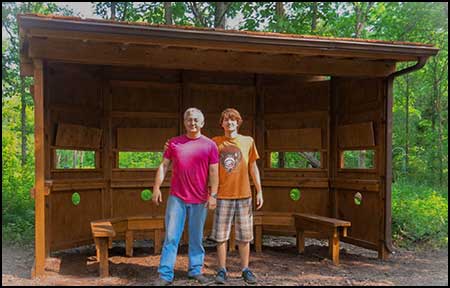
Google search is simple: just type whatever comes to mind in the search box below and hit ENTER or click on the Google Search button. Google will then search the entire chucksville.com website for pages or documents that are relevant to your query!
|
|


